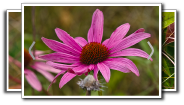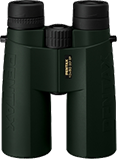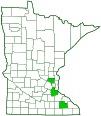common barklouse
(Metylophorus purus)
Conservation • Description • Habitat • Ecology • Distribution • Taxonomy
|
|
||||||||||||||
Description |
Metylophorus purus is a small insect but a relatively large common barklouse. It occurs in the United States and southern Canada east of the Great Plains. It is found on the trunks and branches of both deciduous and coniferous trees, on the shady sides of wood buildings, and on fence posts. The body is soft and bulbous. The head is relatively large for the body. The forehead is swollen. There are four prominent dark marks on the top of the head (vertex) and the upper front of the head (frons). The mouth parts are optimized for chewing. There are nine rod-shaped sensory receptors near the end of the upper lip (labrum). There are four membranous wings, two large forewings and two small hindwings. The forewings are more than ⅛″ (4 mm) in length. The pterostigma is completely clear, and it has a white and black border. There is a well-defined or diffuse spot bordering the branching of the first cubitus vein (M-Cu1), and there is a diffuse brown spot around the junction of the radial sector and the media veins (Rs-M). |
Size |
Forewing length: more than ⅛″ (4 mm) |
Similar Species |
Habitat |
Deciduous and coniferous trees, wood buildings, and fence posts |
Ecology |
Season |
|
Behavior |
Adults are attracted to light at night. |
Life Cycle |
|
Nymph Food |
|
Adult Food |
|
Distribution |
||
|
Sources |
|
| 8/14/2025 | ||
Occurrence |
||
Uncommon in Minnesota |
||
Taxonomy |
|
Order |
Psocodea (barklice, booklice, and parasitic lice) |
Suborder |
Psocomorpha |
Infraorder |
Psocetae |
Family |
Psocidae (common barklice) |
Subfamily |
Psocinae |
Tribe |
Metylophorini |
Genus |
Metylophorus |
Subordinate Taxa |
|
|
|
Synonyms |
|
Psocus genualis Psocus lucidus Psocus purus |
|
Common Names |
|
No species in this genus has a common name, nor does the genus itself. The common name for the family Psocidae is common barklice, and it is applied here for convenience. |
|
Glossary
Frons
The upper front part of an insect’s face, roughly corresponding to the forehead.
Labrum
The upper part of the mouth, sometimes considered the lower part of the face, corresponding to the upper lip, on an insect or crustacean.
Pterostigma
The dark, blood-filled second cell at the leading edge of each wing toward the tip on many insects. It is heaver than adjacent, similar sized areas and is thought to dampen wing vibrations and signal mates. (= stigma. More precise than stigma but less often used, even by entomologists.)
vertex
The upper surface of an insect’s head.
Visitor Photos |
||
Share your photo of this insect. |
||
This button not working for you? |
||
Alfredo Colon |
||
 |
 |
|
 |
||
MinnesotaSeasons.com Photos |
||
|
||
|
||

Slideshows |
|

Visitor Videos |
||
Share your video of this insect. |
||
This button not working for you? |
||
|
Other Videos |
||
|

Visitor Sightings |
||
Report a sighting of this insect. |
||
This button not working for you? |
||
Eileen Jubera |
Location: Saginaw, MN large groups on Arbor vitae tree |
|
Alfredo Colon |
Location: Albany, NY |
 |
MinnesotaSeasons.com Sightings |
||
|

|
Created: 3/22/2025 Last Updated: © MinnesotaSeasons.com. All rights reserved. |
